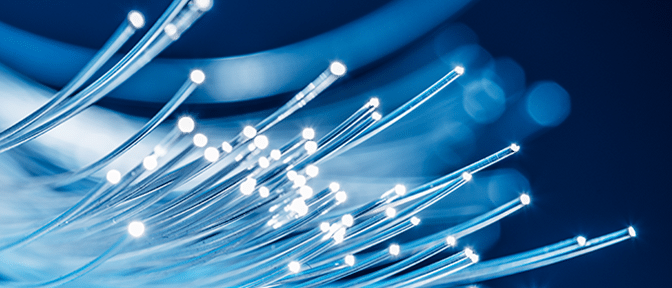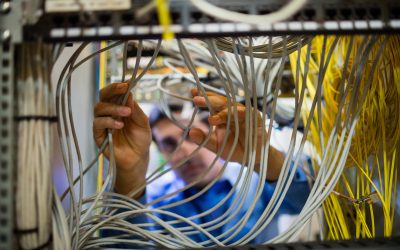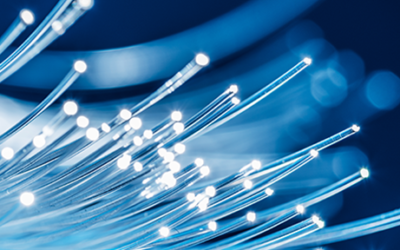A High Fiber Diet Is Essential

In a world where we all expect ubiquitous access to our information and apps, one network infrastructure technology in particular is catering for needs of future networks, that of optical fiber. As the network requirements in both the wired and wireless world fuel the need for high reliability, low latency, high bandwidth and extended distances, fiber optic solutions reach deeper and deeper into the network.
For those that only know ‘fiber’ possibly as a marketing term to sell you the latest broadband service, an optical fiber is a solid strand of glass as thin as a human hair. It is designed to carry information, using pulses of light emitted by a light source (LED or Laser).
Fiber Optic Cabling – Tripping the Light Fantastic!
We are in the midst of change in the way people and systems cooperate and communicate. The trigger for this is the falling price of bandwidth, easy access and arrival of collaborative and converged systems and devices connected to the cloud.
Collaborative systems integrate and extend device and Internet technology, breaking down the barriers between the user and the Internet. They enable people and devices at different locations, possibly in different countries, to work together productively in real-time. This, in turn, reduces the need to concentrate people in large buildings and oblige them to travel simply for face-to-face meetings.
Communication is, of course a key technology in collaboration. Another is a cloud software environment that is not only “personal” but also lets colleagues contribute to a task or project. To make this collaboration fully effective, the systems must replicate the real-time interaction of a face-to-face meeting. That means sharing not only data but also applications, conversations and video images.
Platform for change
Video interaction integrated with devices is radically cutting the cost of remote collaboration. Its impact on network traffic levels, however, is equally dramatic. Typically, streaming video coupled with voice need hundreds of times more bandwidth than text and data files to assure the throughput required, so a very high bandwidth infrastructure is essential to take advantage of real-time collaboration via the user devices.
Quality of service issues are also important to consider. Unlike data, voice and video packets cannot be buffered or delayed between transmitter and receiver. Users will be instantly aware of excessive latency in the network and only a small drop in quality of service will transform video conferencing from a valuable business tool into a frustrating joke.
In network installations, the use of Multi-Gigabit Ethernet in the backbone is now common. With hundreds or even thousands of user devices equipped for voice and video over IP sharing a network, this is not enough. To meet the challenge, 40, 100 and 400 Gb/s fiber technologies have been developed.
“Edge” networks, the domain where wide-area networking and high-capacity cloud networks come into play, are deploying these speeds in cloud and hyperscale datacenters. From the edge out (or in) to the end user, the trend is toward networking with single mode fiber supporting WDM applications in metro/campus applications.
High performance fiber in the backbone is, of course not the complete solution for reliable, high quality streaming media over networks. Throughput to the user must also be maintained through cabling or wireless connectivity.
High bandwidth allows fiber to deliver data rates spanning across the full range from kilobits to megabits to multiple gigabits per second. No other media provides the same cable plant longevity. Installing fiber supports the network infrastructure needs far into the future.
Historically, fiber technology had the image of being difficult to deploy and install but advances in fiber components now provide easy installation. Advances in connector and fiber coating technologies have dramatically reduced fiber termination time. Solutions are available that are optimized for the computer room or data center…. an aerial or underground run between buildings…. a run through high temperatures…. or a run through a rodent infested or corrosive environment. Fiber solutions can be configured with various combinations of multimode and/or singlemode fibers.
Multimode fiber has the capability to meet both the distance and data rate demands of most local networks today. Generally, multimode systems cost less than singlemode systems, since the optoelectronics that can be used with multimode fiber are less costly than those used with singlemode fiber.
In contrast to enterprise networks, singlemode fiber is virtually the only fiber used by wireless and other service provider companies. These industries require the long distance capability and high information carrying capacity of singlemode fiber. Fiber optic infrastructures are becoming common place for feeds to base station antenna, deployments of active DAS (Distributed Antenna Systems), small cell and FTTx deployments.
It is certainly a really exciting time for fiber optic solutions in general. The Cabling Science Institute has a range of easily accessible education content to help you get to grips with the deployment of all types of fiber optic cabling. If you are interested in learning more, take a look at the Fiber Optic Installation or Network Test and Inspection courses.

Written by James Donovan
You might also enjoy
FO Connector Contamination – A Constant Threat
Fiber optic communication most commonly works in duplex or multifiber transmission by transmitting light to a receiver in one direction on a fiber and receiving transmitted light back to a second receiver on the second fiber. Most engineers can understand that and...
Why Inspect and Clean Fiber Optic Connectors?
Inspecting and cleaning of fiber optic connectors during installation and when making any patching, is essential. Any contamination on a patch cord connector will be transferred through the coupler to the connector it is mated to. Even when testing fibers with a test...
Cleaning MPOs
MPO connectors should always be inspected with a scope before they are used, be that on a patch cord or a bulkhead. If they need to be cleaned, one-click cleaners are keyed to ensure the tip only fits one way onto the connectors and is able to clean both male and...


